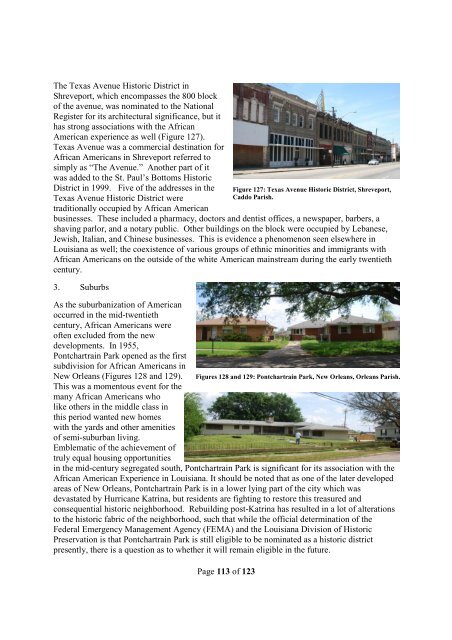The African American Experience in Louisiana
The_African_American_Experience_in_Louisiana
The_African_American_Experience_in_Louisiana
- No tags were found...
You also want an ePaper? Increase the reach of your titles
YUMPU automatically turns print PDFs into web optimized ePapers that Google loves.
<strong>The</strong> Texas Avenue Historic District <strong>in</strong><br />
Shreveport, which encompasses the 800 block<br />
of the avenue, was nom<strong>in</strong>ated to the National<br />
Register for its architectural significance, but it<br />
has strong associations with the <strong>African</strong><br />
<strong>American</strong> experience as well (Figure 127).<br />
Texas Avenue was a commercial dest<strong>in</strong>ation for<br />
<strong>African</strong> <strong>American</strong>s <strong>in</strong> Shreveport referred to<br />
simply as “<strong>The</strong> Avenue.” Another part of it<br />
was added to the St. Paul’s Bottoms Historic<br />
District <strong>in</strong> 1999. Five of the addresses <strong>in</strong> the<br />
Texas Avenue Historic District were<br />
traditionally occupied by <strong>African</strong> <strong>American</strong><br />
bus<strong>in</strong>esses. <strong>The</strong>se <strong>in</strong>cluded a pharmacy, doctors and dentist offices, a newspaper, barbers, a<br />
shav<strong>in</strong>g parlor, and a notary public. Other build<strong>in</strong>gs on the block were occupied by Lebanese,<br />
Jewish, Italian, and Ch<strong>in</strong>ese bus<strong>in</strong>esses. This is evidence a phenomenon seen elsewhere <strong>in</strong><br />
<strong>Louisiana</strong> as well; the coexistence of various groups of ethnic m<strong>in</strong>orities and immigrants with<br />
<strong>African</strong> <strong>American</strong>s on the outside of the white <strong>American</strong> ma<strong>in</strong>stream dur<strong>in</strong>g the early twentieth<br />
century.<br />
3. Suburbs<br />
As the suburbanization of <strong>American</strong><br />
occurred <strong>in</strong> the mid-twentieth<br />
century, <strong>African</strong> <strong>American</strong>s were<br />
often excluded from the new<br />
developments. In 1955,<br />
Pontchartra<strong>in</strong> Park opened as the first<br />
subdivision for <strong>African</strong> <strong>American</strong>s <strong>in</strong><br />
New Orleans (Figures 128 and 129).<br />
This was a momentous event for the<br />
many <strong>African</strong> <strong>American</strong>s who<br />
like others <strong>in</strong> the middle class <strong>in</strong><br />
this period wanted new homes<br />
with the yards and other amenities<br />
of semi-suburban liv<strong>in</strong>g.<br />
Emblematic of the achievement of<br />
truly equal hous<strong>in</strong>g opportunities<br />
<strong>in</strong> the mid-century segregated south, Pontchartra<strong>in</strong> Park is significant for its association with the<br />
<strong>African</strong> <strong>American</strong> <strong>Experience</strong> <strong>in</strong> <strong>Louisiana</strong>. It should be noted that as one of the later developed<br />
areas of New Orleans, Pontchartra<strong>in</strong> Park is <strong>in</strong> a lower ly<strong>in</strong>g part of the city which was<br />
devastated by Hurricane Katr<strong>in</strong>a, but residents are fight<strong>in</strong>g to restore this treasured and<br />
consequential historic neighborhood. Rebuild<strong>in</strong>g post-Katr<strong>in</strong>a has resulted <strong>in</strong> a lot of alterations<br />
to the historic fabric of the neighborhood, such that while the official determ<strong>in</strong>ation of the<br />
Federal Emergency Management Agency (FEMA) and the <strong>Louisiana</strong> Division of Historic<br />
Preservation is that Pontchartra<strong>in</strong> Park is still eligible to be nom<strong>in</strong>ated as a historic district<br />
presently, there is a question as to whether it will rema<strong>in</strong> eligible <strong>in</strong> the future.<br />
Page 113 of 123<br />
Figure 127: Texas Avenue Historic District, Shreveport,<br />
Caddo Parish.<br />
Figures 128 and 129: Pontchartra<strong>in</strong> Park, New Orleans, Orleans Parish.


